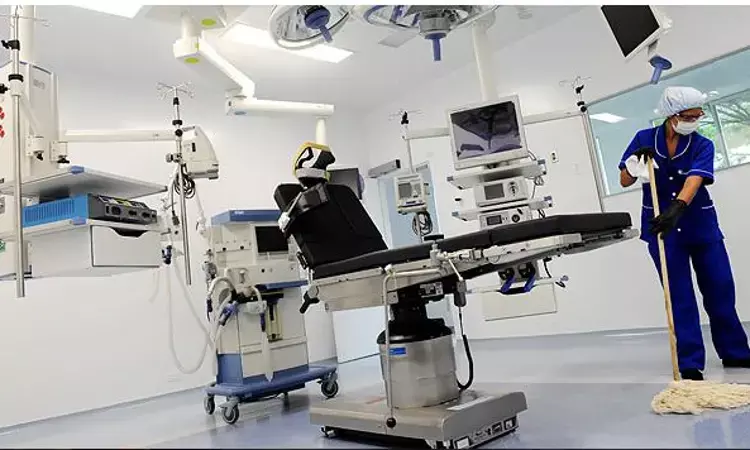- Home
- Medical news & Guidelines
- Anesthesiology
- Cardiology and CTVS
- Critical Care
- Dentistry
- Dermatology
- Diabetes and Endocrinology
- ENT
- Gastroenterology
- Medicine
- Nephrology
- Neurology
- Obstretics-Gynaecology
- Oncology
- Ophthalmology
- Orthopaedics
- Pediatrics-Neonatology
- Psychiatry
- Pulmonology
- Radiology
- Surgery
- Urology
- Laboratory Medicine
- Diet
- Nursing
- Paramedical
- Physiotherapy
- Health news
- Fact Check
- Bone Health Fact Check
- Brain Health Fact Check
- Cancer Related Fact Check
- Child Care Fact Check
- Dental and oral health fact check
- Diabetes and metabolic health fact check
- Diet and Nutrition Fact Check
- Eye and ENT Care Fact Check
- Fitness fact check
- Gut health fact check
- Heart health fact check
- Kidney health fact check
- Medical education fact check
- Men's health fact check
- Respiratory fact check
- Skin and hair care fact check
- Vaccine and Immunization fact check
- Women's health fact check
- AYUSH
- State News
- Andaman and Nicobar Islands
- Andhra Pradesh
- Arunachal Pradesh
- Assam
- Bihar
- Chandigarh
- Chattisgarh
- Dadra and Nagar Haveli
- Daman and Diu
- Delhi
- Goa
- Gujarat
- Haryana
- Himachal Pradesh
- Jammu & Kashmir
- Jharkhand
- Karnataka
- Kerala
- Ladakh
- Lakshadweep
- Madhya Pradesh
- Maharashtra
- Manipur
- Meghalaya
- Mizoram
- Nagaland
- Odisha
- Puducherry
- Punjab
- Rajasthan
- Sikkim
- Tamil Nadu
- Telangana
- Tripura
- Uttar Pradesh
- Uttrakhand
- West Bengal
- Medical Education
- Industry
Central line-associated bloodstream infections on the rise during Covid pandemic: Study

From 2015 to 2019, there was a 31% decline in the national Standardized Infection Ratio (SIR) for central line-associated bloodstream infections (CLABSIs), suggests the findings of a recent study, published in Infection Control & Hospital Epidemiology. On the contrary, the research team observed that , in the face of the pandemic of SARS-CoV-2, healthcare-associated infections in hospitals may have increased."
Infection control practices changed in many healthcare settings during the pandemic to accommodate increasing numbers of patients and to mitigate shortages of personal protective equipment, supplies, and staffing.Reducing the frequency of contacts with patients and of maintenance activities for central catheters (e.g. chlorhexidine bathing, scrubbing the hub, site examinations) as well as alterations to processes of care (such as risking disrupting catheter dressings when placing patients in a prone position) all have the potential to contribute to an increase in CLABSIs."the team opined.
To have a greater understanding on such dynamics,the team of researchers conducted a recent study to understand the impact of the early months of the COVID-19 pandemic on CLABSIs nationally, SIRs for 2020 quarter 2 (Q2: April, May, June) were compared to those from 2019 Q2.
This analysis included data as of January 1, 2021 from acute care hospitals (ACHs) for April, May, and June of 2019 and 2020. Only locations that had continuous and consistent reporting, defined as ACHs reporting all three months of CLABSI data for the same location in both 2019 Q2 and 2020 Q2, were included.
Data analysis revealed some important facts.
The analysis included 13,136 inpatient units from 2,986 ACHs. 936 facilities had at least one predicted CLABSI and an SIR calculated. A 28% increase (95% CI 20.0, 33.6) was observed in the national SIR, from 0.68 in 2019 Q2 to 0.87 in 2020 Q2 (Table 1). Device utilization increased nationally from 0.21 in 2019 Q2 to 0.23 in 2020 Q2 .
Critical care units had the greatest percentage increase (39%) in SIR, from 0.75 in 2019 to 1.04 in 2020.
Ward locations experienced the second highest increase (13%).
Critical care locations had the highest number of CLABSIs in 2020 Q2, with 1,911 events. Hospitals in all bed size categories experienced an increase in SIR.
In 2020 Q2, reporting of CLABSI surveillance dropped by 17% nationally, in contrast with 2019 Q2. The greatest decrease in reporting (48%) occurred in the Middle Northeast.
For the full article follow the link: DOI: 10.1017/ice.2021.108
Primary source: Infection Control & Hospital Epidemiology
Dr Satabdi Saha (BDS, MDS) is a practicing pediatric dentist with a keen interest in new medical researches and updates. She has completed her BDS from North Bengal Dental College ,Darjeeling. Then she went on to secure an ALL INDIA NEET PG rank and completed her MDS from the first dental college in the country – Dr R. Ahmed Dental College and Hospital. She is currently attached to The Marwari Relief Society Hospital as a consultant along with private practice of 2 years. She has published scientific papers in national and international journals. Her strong passion of sharing knowledge with the medical fraternity has motivated her to be a part of Medical Dialogues.
Dr Kamal Kant Kohli-MBBS, DTCD- a chest specialist with more than 30 years of practice and a flair for writing clinical articles, Dr Kamal Kant Kohli joined Medical Dialogues as a Chief Editor of Medical News. Besides writing articles, as an editor, he proofreads and verifies all the medical content published on Medical Dialogues including those coming from journals, studies,medical conferences,guidelines etc. Email: drkohli@medicaldialogues.in. Contact no. 011-43720751


